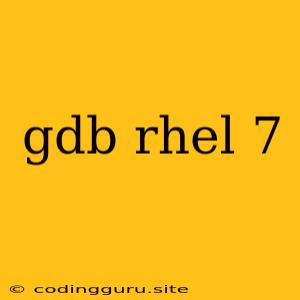Navigating the Debugging Landscape with GDB on RHEL 7
The world of software development often involves navigating the treacherous terrain of bugs. These unwelcome companions can bring development to a standstill, leaving you scratching your head and searching for answers. Thankfully, powerful tools like GDB (GNU Debugger) exist to help you conquer these debugging challenges.
In this guide, we'll explore the realm of debugging with GDB specifically on Red Hat Enterprise Linux 7 (RHEL 7), a robust and widely-used operating system.
Understanding GDB's Role
GDB is your trusty companion when it comes to understanding and resolving issues within your code. It allows you to step through your program line by line, inspect variables, and even modify their values on the fly. Think of it as a detective's toolkit for unmasking the root causes of program behavior.
Getting Started with GDB
-
Installation: On RHEL 7, you'll likely find GDB pre-installed. However, if it's not present, you can easily install it using the following command:
sudo yum install gdb -
Compiling with Debugging Symbols: To use GDB effectively, you need to compile your program with debugging symbols enabled. This allows GDB to associate your code with the executable. For example, if you're using GCC, you can add the
-gflag during compilation:gcc -g my_program.c -o my_program
Debugging with GDB: A Practical Approach
Now, let's dive into a practical example of using GDB to debug a C program.
-
Launching GDB: Start GDB by typing the following command in your terminal, replacing
my_programwith the name of your executable:gdb my_program -
Setting Breakpoints: Breakpoints are essential for controlling the flow of execution. To set a breakpoint at a specific line, use the
breakcommand followed by the line number or function name:break mainThis will pause execution at the beginning of the
mainfunction. -
Running Your Program: Use the
runcommand to start the program. GDB will execute your program until it encounters the breakpoint. -
Inspecting Values: Once the program pauses at the breakpoint, you can use various commands to explore its state. Some useful commands include:
-
print: Display the value of a variable. For example:print x -
next: Execute the current line and move to the next. -
step: Step into a function call. -
continue: Resume execution until the next breakpoint or the program ends.
-
Example Walkthrough
Let's say you're debugging a C program with a simple addition function:
#include
int add(int a, int b) {
return a + b;
}
int main() {
int result = add(10, 20);
printf("Result: %d\n", result);
return 0;
}
-
Compile with Debugging Symbols:
gcc -g add.c -o add -
Launch GDB:
gdb add -
Set a Breakpoint: We'll set a breakpoint at the beginning of the
addfunction:break add -
Run the Program:
run -
Inspect Values: Once the program pauses at the breakpoint, you can use the
printcommand to see the values of theaandbparameters:print a print b -
Step Through the Function: Use the
nextcommand to step through the function and observe how the value ofa + bis calculated.
Troubleshooting Tips
-
Missing Symbols: If GDB complains about missing symbols, ensure your program was compiled with the
-gflag. -
Core Dumps: For unexpected crashes, generating core dumps can provide vital clues. You can enable core dumping on RHEL 7 by using the
ulimit -c unlimitedcommand. -
GDB Documentation: GDB has a rich set of commands and features. Refer to the GDB documentation for detailed information.
Key Benefits of Using GDB on RHEL 7
-
Precise Debugging: GDB allows you to pinpoint the exact line of code where an issue occurs.
-
Variable Inspection: You can inspect variables at any point in the program's execution.
-
Conditional Breakpoints: Set breakpoints that trigger only under specific conditions.
-
Memory Inspection: Examine memory addresses and their contents.
Conclusion
GDB on RHEL 7 is a potent tool for debugging your applications. By understanding its core functionalities and leveraging its diverse commands, you can effectively identify and resolve errors, ultimately leading to more stable and reliable software. Remember, every successful software project benefits from a skilled debugging arsenal, and GDB is your trusted weapon in this fight.
